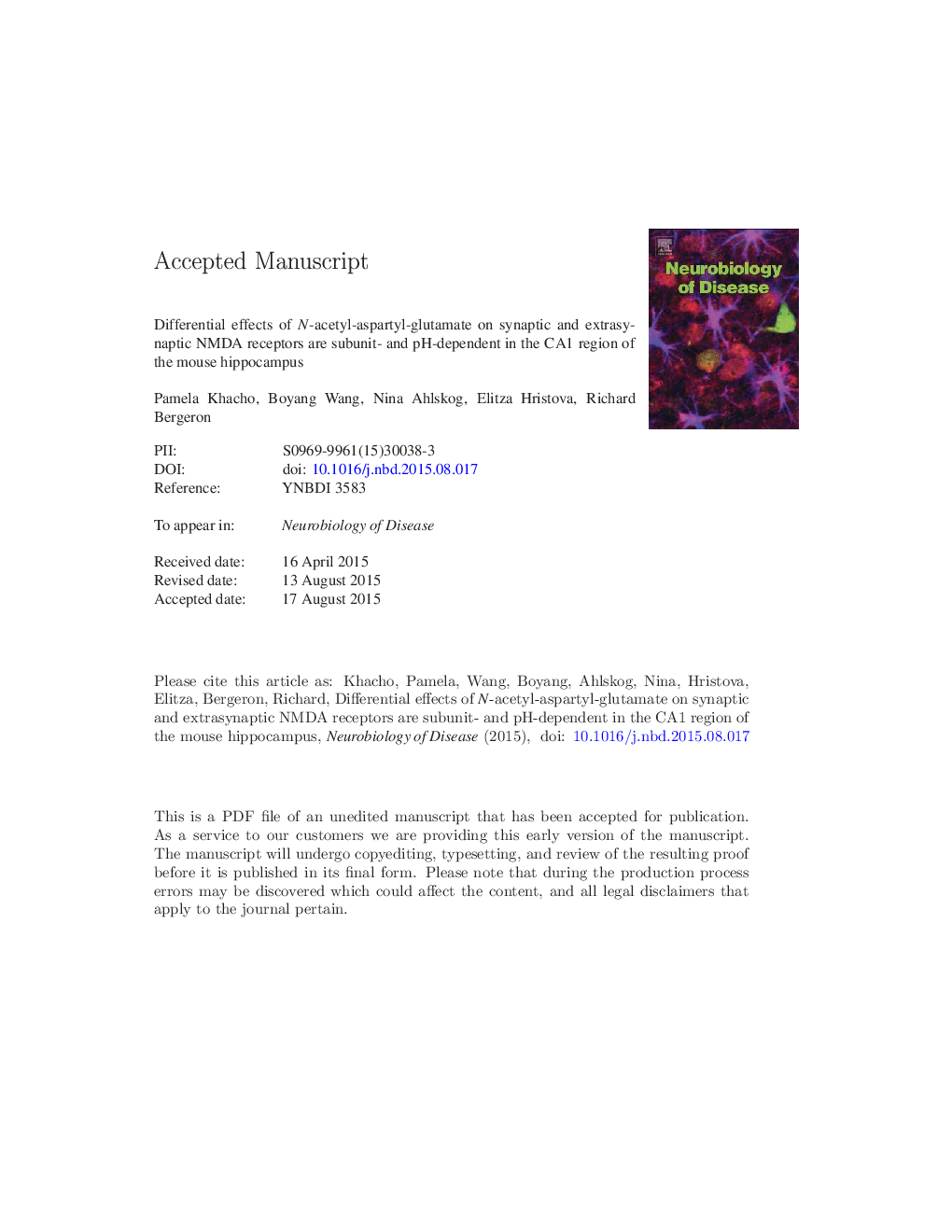| کد مقاله | کد نشریه | سال انتشار | مقاله انگلیسی | نسخه تمام متن |
|---|---|---|---|---|
| 6021660 | 1580641 | 2015 | 48 صفحه PDF | دانلود رایگان |
عنوان انگلیسی مقاله ISI
Differential effects of N-acetyl-aspartyl-glutamate on synaptic and extrasynaptic NMDA receptors are subunit- and pH-dependent in the CA1 region of the mouse hippocampus
دانلود مقاله + سفارش ترجمه
دانلود مقاله ISI انگلیسی
رایگان برای ایرانیان
کلمات کلیدی
N-acetyl-aspartyl-glutamatemGluR3metabotropic glutamate receptor 3NAAGaCSF2-(phosphonomethyl)pentanedioic acid2-PMPANMDARCREBBDNF - BDNF یا فاکتور نورونزایی مشتقشده از مغز EPSC - EPSCoRElectrophysiology - الکتروفیزیولوژیBiotinylation - بیوتینیل شدنexcitatory postsynaptic current - جریان پستیینپتیک تحریک کنندهBrain-derived neurotrophic factor - فاکتور نوروتروفی مشتق شده از مغزartificial cerebrospinal fluid - مایع مغزی نخاعی مصنوعیNeuroprotection - محافظت نورونی یا محافظت از عصبHippocampus - هیپوکامپ cAMP response element binding protein - پروتئین اتصال دهنده عنصر پاسخ cAMPProtons - پروتون هاN-methyl-d-aspartate receptor - گیرنده N-methyl-d-aspartateNMDA receptors - گیرنده NMDA
موضوعات مرتبط
علوم زیستی و بیوفناوری
علم عصب شناسی
عصب شناسی
پیش نمایش صفحه اول مقاله

چکیده انگلیسی
Ischemic strokes cause excessive release of glutamate, leading to overactivation of N-methyl-d-aspartate receptors (NMDARs) and excitotoxicity-induced neuronal death. For this reason, inhibition of NMDARs has been a central focus in identifying mechanisms to avert this extensive neuronal damage. N-acetyl-aspartyl-glutamate (NAAG), the most abundant neuropeptide in the brain, is neuroprotective in ischemic conditions in vivo. Despite this evidence, the exact mechanism underlying its neuroprotection, and more specifically its effect on NMDARs, is currently unknown due to conflicting results in the literature. Here, we uncover a pH-dependent subunit-specific action of NAAG on NMDARs. Using whole-cell electrophysiological recordings on acute hippocampal slices from adult mice and on HEK293 cells, we found that NAAG increases synaptic GluN2A-containing NMDAR EPSCs, while effectively decreasing extrasynaptic GluN2B-containing NMDAR EPSCs in physiological pH. Intriguingly, the results of our study further show that in low pH, which is a physiological occurrence during ischemia, NAAG depresses GluN2A-containing NMDAR EPSCs and amplifies its inhibitory effect on GluN2B-containing NMDAR EPSCs, as well as upregulates the surface expression of the GluN2A subunit. Altogether, our data demonstrate that NAAG has differential effects on NMDAR function based on subunit composition and pH. These findings suggest that the role of NAAG as a neuroprotective agent during an ischemic stroke is likely mediated by its ability to reduce NMDAR excitation. The inhibitory effect of NAAG on NMDARs and its enhanced function in acidic conditions make NAAG a prime therapeutic agent for the treatment of ischemic events.
ناشر
Database: Elsevier - ScienceDirect (ساینس دایرکت)
Journal: Neurobiology of Disease - Volume 82, October 2015, Pages 580-592
Journal: Neurobiology of Disease - Volume 82, October 2015, Pages 580-592
نویسندگان
Pamela Khacho, Boyang Wang, Nina Ahlskog, Elitza Hristova, Richard Bergeron,